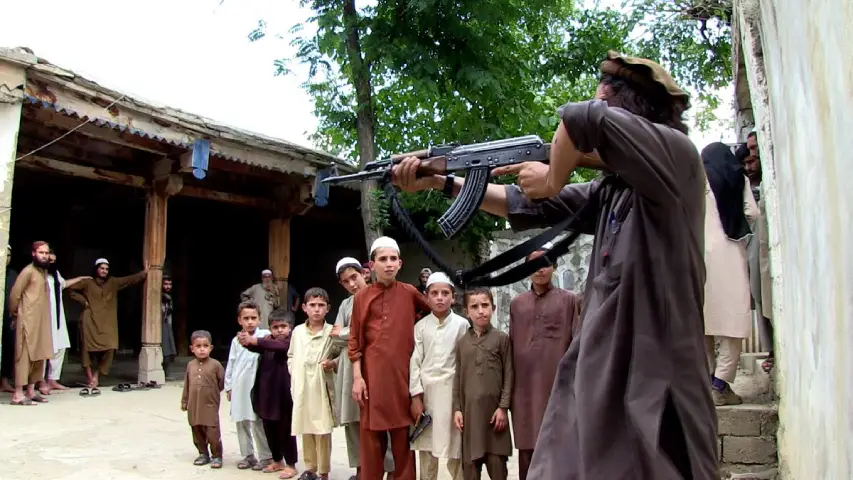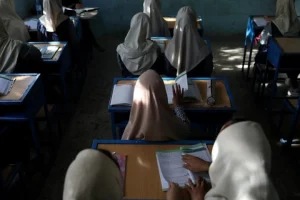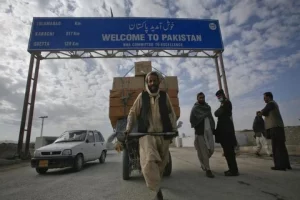With the two years of Taliban reign, experts deliberate whether Afghanistan would remain a state providing safe havens to terror factions in the years ahead. Some apprehensions were confirmed, when Washington identified the hideout of al-Qaeda leader Aimen al-Zawahiri in Kabul, eliminating him in a drone strike. The sheer presence of Al Zawahiri in Kabul, after multiple assurances from Taliban leadership during and post-Doha agreement claiming to have distanced themselves from the group, continues to question the legitimacy of their promise and raises concern over the future of Afghanistan as a safe haven for Islamist factions.
Followed by the drone strike, neighbouring nations were forced to argue on a region based counterterrorism strategy to mitigate possible threats emanating from Afghanistan. With Washington drawing some satisfaction from the Taliban’s aggressive response against the Islamic State in Khorasan (ISKP) — neighbouring economies are forced to argue on the possible fallout from Taliban’s actions with serious ramifications to regional peace and stability, which according to Washington can be termed as Taliban countering terror groups in their country.
With the completion of two years, experts argue on the future of Afghanistan as a terror state, a priority concern for roughly all scholars focussing on the region. Yet, many Afghan watchers do not explicitly point their concerns over the Taliban as a contributing factor. Instead, they point towards numerous Islamist factions including Al Qaeda and growing recruits within the Islamic State, expanding their influence taking advantage of the instability in the Hindukush.
To that end, among those militant factions, the Islamic State affiliate in Afghanistan locally known as the Islamic State in Khorasan takes the most priority for Taliban leadership. Credited to numerous successful assassinations of key Taliban leaders, the author aims to forecast possible trajectory of the ISKP, identifying its core characteristics, analysing affiliate Wilayat’s and making key recommendations for regional economies, through New Delhi’s eyes.
That said, according to the author, post the second anniversary of the Taliban rule will witness a period of strengthened ISKP, with Taliban potentially extending efforts to counter the menace, resulting in rifts within the group’s leadership, giving leverage to other Islamist factions potentially affiliating with the Islamic State. ISKP menace could instigate serious consequences not only for the region but an activated periphery in Kashmir. That said, what are the options for New Delhi? In the light of a technical team in Kabul, is the time ripe for New Delhi to define a dedicated counterterrorism policy?
Altering modus operandi in Afghanistan?
The core operations of the ISKP are Pakistan and Afghanistan. Although the Islamic State has expressed subtle ambitions operating outside its core areas, its modus operandi reflects some ties with locally affiliated militant factions pre-existing in the region. The flexibility to operate with loosely affiliated groups have reinforced Islamic State’s ability to launch aggressive attacks outside its traditional periphery.
Since the fall of Kabul, ISKP has grown exponentially in its Wilayats and so has their level of aggression against the Taliban. One of the key objectives of the ISKP is to prevent the Taliban from delivering what it promised: peace and stability to the Afghan people, and a legitimate ruler to the international community.
In the second year of Taliban’s rule, ISKP reintroduced the guerilla tactics in its urban warfare campaign, The logic was to target key Taliban leaders in urban cities of key provinces thereby highlighting vulnerability, questioning their ability to protect local masses and inability to defend their own. This resulted in series of attacks against governors, a string of attacks, in Nuristan, Nangarhar provinces, brutal suicide attacks targeting the governor and bombing Seh Dokan Mosque in Mazar-e Sharif, dedicated strikes against the Shia community in Wardak, Shia Hazaras in Kabul City to name a few. According to pro-ISKP sources, the decision to reintroduce guerrilla tactics in urban warfare campaigns was made in the Shahab al-Muhajir’s shura, directing provincial commanders and all affiliate group members to employ guerilla tactics in urban areas, while targeting key leadership.
That said, the change in tactics gave some respite to the morals of young recruits, who joined the group for territorial control, demonstration of power and exercise/inculcating their interpretation of sharia on local masses. According to pro-ISKP sources, the group thrives on finances, in particular donations from sympathetic clerics and Islamist non-governmental organizations across Central Asia and Saudi Arabia. Since early 2023, there has been a dip in recruitment, resulting in the emir Al-Muhajir, to distribute manpower within its Wilayats. With renewed attacks on key Taliban leadership, one may argue that a changed strategy could potentially put Taliban under pressure, and with an absence of air campaign, Taliban’s counter offensives would largely limit to assaulting identified/known hideouts or apprehending ISKP sympathisers. According to an expert, in June 2023 Taliban could identify possible ISKP presence in Nuristan and Nangarhar, resulting in the arrest of a handful alleged sympathisers, in the past two months.
Without a doubt, the change in strategy for ISKP may deliver tactical results, but fails to deliver recruitment numbers, capping their numerical strengths. Their internal communication points towards a clash of opinions between those voicing to retain the strategy of territorial control against those voicing for guerrilla tactics, consolidating their losses in the light of fewer recruitment last year. According to pro-ISKP sources, unlike Iraq and Syria, the emir Al Muhajir’s shura has achieved consensus on prioritizing assassinations of Taliban leadership over focussing on territorial control, which has disgruntled many lower echelon leaderships. With a change in strategy, we are yet to witness altering allegiances of disgruntled ISKP lower echelons.
An existential crisis: IS in Pakistan Wilayat
In Pakistan, the Islamic State operates on two cadres, administratively controlled by a dedicated unit known as the Islamic State-Pakistan Province or ISPP. The ISPP came into existence in May 2019, formally separating itself from ISKP:
- a) Former members of the TTP, predominant Salafis of the northwestern Khyber Pakhtunkhwa (KPK) Province.
- b) Anti-Shia sectarian affiliates, operating in the southern Balochistan Province
The difference in achieving political objectives drew a wedge in Al Muhajir’s shura, resulting in the emir creating a dedicated yet separate Islamic State administrative unit for Pakistan, making a division based on geography: a unit each for Afghanistan and Pakistan. Also, experts argue, by creating ISPP, the emir Al Muhajir desired to demonstrate regional strength, an effort to rally its fighters and shadowing images of the fall of IS in Syria and Iraq. Till date, according to this scholar, the ISPP has made no significant impact either in its operational activities, strategy or expanding its recruitment in the region or beyond.
BREAKING:
Counter Terrorism Department (CTD) Balochistan has carried out an operation in Mastung city, Balochistan which led to the killing of top Islamic State Pakistan (ISPP) commander Ghulam Din Shahwani aka Shoaib.
According to the most wanted terrorist Federal Government’s… pic.twitter.com/pmk5zDskyz— The Khorasan Diary (@khorasandiary) September 13, 2023
In 2021, the ISPP was reduced after its inability to defend/retain influence in the KPK, whose members were absorbed within the ISKP Afghanistan administrative unit. Experts argue that the ISKP restructuring was to renew the emir’s efforts to strengthen ISKP ‘s fight against the Pakistani state and seek maximum affiliation from smaller Islamist factions operating in the KPK.
However, the merger limited ISKP’s operational capabilities to merely guerilla (Taliban strengthened borders, challenging ISKP to provide continued means and materials) potentially damaging ISKP’s ability to operate independently in the region.
In 2023, the Islamic State did not demonstrate any capability that could possibly point towards it seriously challenging the Pakistani state and currently has no realistic path to its strategic objectivity. Taking note of its current trajectory, it is highly unlikely for the group to achieve strategic victory even in 2024. In KPK, Islamic State employs small unit tactics involving RPG to target convoys or individuals with alleged affiliations to other factions, law enforcement or state departments or other ethnic diversities. It employs limited IEDs against the same group of targets which the author estimates will drop down in 2024.
That said, the tempo maintained by Islamic State can be considered as falling. The trend began to fall in the first seven months of 2022, where the Islamic State conducted few attacks which dropped down to a handful in the later half. In 2023, the attacks became fewer and the trajectory pointed towards a handful in 2024. This reflects ISKP to be under extreme stress both in Afghanistan and in Pakistan, with the group facing different challenges in different geographies. In Afghanistan, Taliban has mounted counterinsurgency against the group, and conducted numerous raids, executions of suspected sympathisers which could have weakened the group. This could have resulted in decreased attacks against the Taliban in Afghanistan, but that is not the case in Pakistan as the author did not find dedicated countermeasures/offenses employed by the Pakistani state against the group.
It is safe to say that, at least in part, the fall of ISKP can be attributed to the rise/strengthening of TTP. In 2023, the TTP began centralizing control over its affiliate groups, reintegrating reintegrating even the most disgruntled factions. In doing so, the TTP has denied ISKP in filling their ranks, crippling their ability to recruit from the regions of KPK and surrounding areas. In late 2021, there was a surge in recruitment of ISKP with recruits having previously aligned with the TTP . The TTP’s centralised control and military efficiency/victory will prevent affiliates to change allegiance, resulting in less recruits joining the ISKP in 2024.
Reportedly TTP killed an alleged ISKP member working for Pakistani intelligence against the TTP. pic.twitter.com/P1BTCqBQgg
— Koustuv 🇮🇳 🧭 (@srdmk01) September 4, 2023
Recruits drawn to the ISKP will either believe in its interpretation of sharia/ideology or disgruntled members of the TTP, who agree with targeting local marginalised communities, ethnicities, or have personal connections/ties through active members. Putting aside ideology, the chances of disgruntled members breaking away from the TTP is not foreseeable in the near future. By the end of 2023 the group could struggle to gather fresh recruits, which will take a dip in 2024.
Inspite of this drawdown, ISKP will aim to conduct more attacks with higher crates of casualty during the remaining months of 2023 and early 2024. In 2020, the ISKP not only increased the frequency of attacks but also in lethality, when it was militarily pressured to surrender territories it held by then then Afghan National Security & Defence Forces (ANSDF), giving a notion of its response under extreme military pressure. That said, the group is unable to coordinate attacks both against the Pakistani state forces and the Taliban, and may target civilian areas rather than military installations.
If, hypothetically, the ISKP does target civilian areas, it will employ suicide bombers for heavy casualties. ISKP has evolved suicide tactics from its experiences in Iraq and Syria, which it has no shortage of arsenal in Pakistan, a preferred way to create mass casualties. The recent suicide bombing conducted at an election rally of Jamiat Ulema-e-Islam Fazl (JUI-F), makes a total of 16 suicide attacks it has conducted since 2016 in Pakistan, claiming more lives than any other Islamist faction in the region.
That said, the time is ripe for ISKP, if it does continue to display its presence and strength through suicide bombings. ISKP has a history of targeting religious sites, which offers both notoriety and appeal to intended Islamist factions to seek allegiance. Pakistan parliamentary elections will be held in less than 90 days (from dissolution of National Assembly on 10 August) making political events accessible, prone/vulnerable and too high profile for attacks.
Taliban’s military pressure and TTP’s growing alliances are resulting in significant decline of ISKP’s influence in the region. It rests majorly on regional economies to develop a dedicated counterterrorism policy to eliminate the group while it is most vulnerable. One possibility emerges in the form of a counterterrorism alliance within the SCO against ISKP, sharing of resources, intelligence within partnered groups and allied agencies involving limited intelligence exchange with Taliban’s GDI under stringent conditions.
Assumingly, the ISKP survives under extreme pressure in both Pakistan and in Afghanistan, it will be confined to no more than a local threat, operating in KPK and at best Balochistan. That said, the group continues to prove its resilience in Iraq & Syria to which the rigorous terrain on the Pakistan-Afghanistan border may give some respite, providing ISKP haven to limit its losses. If that situation arises, ISKP will have to limit its tactics to conducting political assassinations and high-profile suicide attacks in civilian areas of KPK and Balochistan.
Taking note of the group’s current trajectory, ISKP’s fate can be analysed to three possible scenarios in 2024:
- a) If the ISKP finds new/innovative ways to operate, the group may not elevate to the levels of a regional threat, but could potentially challenge Pakistani state forces. It could seriously challenge the state of Pakistan, and maintain significant hold in Khyber Pakhtunkhwa and surrounding areas. Taking note of extreme scenario, ISKP could at best install safe havens in the north western regions of Pakistan, allowing it to expand the group’s influence on the borders and surrounding regions, potentially threatening immediate neighbours including India. Scenarios such as this, represents greater to neighbouring economies including India, but it may not prove itself as a potent regional threat even if TTP loses its influence in the region.
- b) If the TTP and Taliban continue to pressurise the group in Pakistan and in Afghanistan, and ISKP fails to amplify/demonstrate its strength, it is likely for the group to thrive in the shadows of inactivity and irrelevance and may experience desertion even by the most loyalists. In such a scenario, ISKP will lose its operational strength, drawing down to smaller cells and target civilian and military forces, with minimal impact, contributing to increased violence in the region at best, without the ability to challenge other Islamist factions operating in the Afghanistan-Pakistan border region.
- c) The author does not foresee joint operations conducted by Pakistani state military forces and Taliban or a collaboration between the two entities against the Islamic State operating on the borders, taking note of their disagreement on the issue of Pashtunistan. Pakistani state agencies are concerned about the TTP’s influence in the region and according to pro-ISKP sources, have trained factions within the ISKP, to counterbalance. That said, ISKP took measures to adapt after losing territorial control in Afghanistan and may improvise its operations again. That could limit the group to no more than a local threat, in the long run, until and unless there is drastic change in regional/current scenarios enabling it to carry continued attacks in the region and beyond.
An active Wilayat? The future of Islamic State Hind Province
On 10 May 2019, the Islamic State announced a dedicated province for India (wilayah), grouping local affiliate and sympathetic groups under the administrative control of IS-Hind (IS-H) province, with a central figure reporting to Al Muhajir’s shura directly. The IS-H aimed to increase local recruitment and re-instigate Islamist militancy in the region. To that end, the IS-H launched several propaganda campaigns to gather sympathisers on a pan-India level.
Terrorists of IS-Hind (India) with their own Black Flag designs pose pledge allegiance (bay’a) to Abu al-Husayn al-Qurashi, the new IS amir.
(1/2) pic.twitter.com/1LHSvozC34— Eagle Eye (@zarrar_11PK) December 8, 2022
Initially, the IS-H probed the strategy of recruiting pro-IS Indian affiliates and sympathisers under its wings, including locally radicalised youths from Kerala and Kashmir, and those fighters with credible combat experience, operating in the Islamic State held regions of Afghanistan. For centralised control, locally affiliate groups such as Ansar-ul-Khilafah Jammu & Kashmir and Kerala unit along with Jundul Khilafah Kashmir, took orders directly from the IS-H. With that, the IS-Hind hierarchical architecture, was dominated by local Kashmir radicals, limiting its influence to the region.
An unholy alliance for Kashmir?
Today, the relationship between Islamic State militants, their affiliates and those of other active militant groups appears to be more fluid in comparison to IS stance in Pakistan, Afghanistan and elsewhere in the world. With jihadist movement becoming increasingly polarized in the regions analysed above, Islamist factions operating in the region are not influenced by their distinctions or groups’ religious beliefs.
With a large Muslim population, India continues to experience the dip in militant attacks unlike other nations, which is largely credited to its robust counterterrorism capabilities, which took a major shift after the 2019 Pulwama attack. Today, the state’s counterterrorism capability has pressured the IS-H operational mechanism. Consequently, there has been no operational activity in the early 2023, with the group conducting only two attacks in 2022.
Under extreme pressure, the IS-H may concentrate its attention to strengthen its media/propaganda in the rest of 2023. The trajectory can be traced to the announcement of its official news outlet Nashir al-Hind, on April 13, 2022. IS-H may also look to strengthen its propaganda using outlets such as al-Tazkirah and al-Burhan. Furthermore, the group launched a new outlet Al-Jauhar Media Centre, issuing its first edition of an English-based propaganda magazine titled Serat ul-Haq. The author does not foresee IS-H retaining some tactical presence or carrying out any attacks in the near future, but it may dominate social media space by releasing propaganda literature using IS-affiliated media, making propaganda a core strategy in Kashmir.
The IS-H will continue to target certain Muslim communities that may feel marginalised in the political landscape in the region and pan-India. This may result in IS-H developing recruitment-based organizations, which may send potentially ripe recruits across the border for training. However, taking note of current trajectory, IS-H may increase recruitment of potential sympathisers, locally for transliteration/interpretation and dissemination of propaganda materials at a pan-India level. That said, the landscape of militancy in Kashmir is a door shut for ISKP, at least from a tactical perspective, however, it may still seek allegiance to potentially increasing affiliate groups, which may target civilians and security forces in the region bearing its flag.
Conclusion and Policy Recommendations
Taking a look at ISKP’s trajectory for the year 2022 & 2023, it is highly likely for the group to conduct attacks against neighbouring states in 2024, which makes ISKP operating locally with the objective of countering Taliban in Afghanistan and retaining significance in Pakistan-Afghanistan border. The ISKP may claim the narrative of being the only group successfully conducting global jihad, undermining Al Qaeda and branding Taliban as being confined to territorial ambition alone. That said, for ISKP, loosing influence in the Af-Pak region and potency to conduct attacks against the Indian state, is least of its problems. A successful campaign against the Taliban would instead boost the morale of its affiliates and those still hurling the flag in AfPak region while renewing their hope in the Khorasan, undermining Taliban as the sole legitimate ruler of Afghanistan. ISKP may counterpressure Taliban by branding it an entity unable to prevent Afghanistan from becoming a terror safe- haven, subjecting it under intense sanctions/pressure from international communities.
Using that as an incentive, counter-pressuring the Taliban through actions that question its legitimacy, is a tactic that ISKP may use in 2024.
According to the author, following challenges may curtail Islamic State from conducting activities in Afghanistan, Pakistan and India in 2024:
- a) ISKP is in dire need of recruits. Its affiliates, by the fall of 2023 and early 2024 may switch allegiances, including those affiliated groups operating in Kashmir. This would result in a weak hierarchical architecture in Wilayats, impacting the organizational leadership’s ability to plan attacks.
- b) ISKP may enhance its focus on Afghanistan. The author does not imply that it would hastily abandon its presence in Kashmir. But, it may continue to recruit radicalised youths employing them in Afghanistan, which would mean limited to no kinetic action in Kashmir or pan India.
- c) ISKP, unlike the ISIL, failed to influence radicalised youths from West and South Asia to join their ranks. Instead, sending trained recruits to the origin country, ISKP is forced to send recruits to reinforce depleting ranks in Afghanistan.
That said, for New Delhi, the most serious risk rests majorly on the ISKP’s ability to influence militant factions operating in Kashmir to seek their affiliation. As analysed in detail, the ISKP may not have the ability to target civilians and security forces. However, it does possess tech savvy youths who can instigate certain lone wolves and instruct them to attack, claiming their affiliation later. The probability of its occurrence is low.
ISKP poses an immediate threat in Kashmir, as detailed above not through its kinetic action, but through online propaganda, passive recruitment practices, which is far more dangerous than active recruitment, potentially with time luring radicalised recruits to form sleeper networks, waiting for conducive operational conditions in the region.
Taking note of the aforementioned assessment, what steps should New Delhi take to counter the ISKP menace? Should New Delhi formulate a regional cooperation induced counterterrorism policy enabling partners to perhaps, counter/mitigate the threats jointly?
With the Taliban completing two years, New Delhi has limited opportunities but efficient resources in countering the ISKP threat, not just domestically, but as a regional stakeholder.
To that end, the author provides certain recommendations that could enable New Delhi to counter the ISKP menace, not just domestically, but regionally, taking the shape of a regional alliance against terrorism as a whole:
1) Identifying the possibility of a small-scale cooperation on counterterrorism between SCO (under India’s leadership) & Taliban
Putting aside the nature of political sensitivity, the SCO is in a perfect position to formulate a counterterrorism cooperation with the Taliban, under the leadership of New Delhi. With a robust counterterrorism policy and a technical team in Kabul, New Delhi is in perfect position to spearhead SCO’s small-scale cooperation with Taliban, exclusively on terrorism. With roughly all member states within the SCO engaging with Taliban independently, this would enable New Delhi to strengthen its commitment to the people of Afghanistan, while keeping a check on certain nations’ ambitions on the ground. Without external cooperation, ISKP will pose a serious threat to Afghanistan’s security. Hence, small scale cooperation under New Delhi’s leadership, would bring allied nations from the West, particularly the US, to provide technical intelligence without engaging with Taliban directly or expanding its military power or granting political legitimacy. Without putting boots on the ground, SCO member nations will achieve the unique ability to track/seek information on known terror actors operating inside Afghanistan.
2) Maximising capability of neighbouring states to counter radicalisation
Taking the note of India’s robust counterterrorism policy, nations such as Bangladesh, Myanmar, Sri Lanka and Maldives lack the capacity to counter radicalisation. A dedicated regional counter-radicalisation program could strengthen cooperation and develop mutual trust as well as skill enhancement for military and law enforcement institutions in the said nations, through joint trainings on SIGINT, thereby maximising their potency counter potential threats not only from probable Islamic State-affiliated groups but also from domestic jihadi networks flourishing in respective states.
3) Regional efforts to counter jihadi propaganda
As analysed above, Kashmiri youths are being chiefly targeted by Islamist factions such as the ISKP in their propaganda campaigns. Targeting them, they disseminate their propaganda with the objective of influencing members of the Muslim communities across India. This tactic is not only employed in Kashmir but the production of extremist propaganda and its online circulation through social media platforms such as Facebook and Telegram, occurs in roughly every nation in the region and across the globe. The only effective solution is to disrupt their networks by apprehending those driving it, as well as those that are constantly producing the propaganda using sleeper cells, broadcasting it to larger audiences across the globe.
Disrupting such platforms will involve a robust strategy which should be implemented from a regional to a global approach. New Delhi must propose an initiative to counter violent extremism through propaganda under the aegis of the United Nations Security Council’s Counter Terrorism Executive Directorate (CTED) and a dedicated framework under its G20 presidency, with an objective to disrupt propaganda dissemination, before it reaches the intended audience in regional/ local languages.
Also Read: Iran and Taliban bond to counter rise of Islamic State in Afghanistan




















